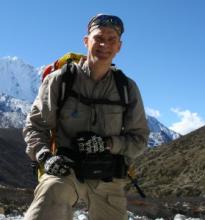IT Lessons Learned From The Top Of Mount Everest
Submitted by Tom Spring on

On Hobson’s third Everest attempt, in 1997, he approached the problem with new insights, a different strategy and new vigor. His team attacked the mountain from its southern, Nepalese side. In a nod to outsourcing, he contracted out the organizational and leadership pieces of the climb. That freed Hobson to focus exclusively on training and fund-raising for the adventure. The strategy paid off. He made it to the summit.
Climbing Back From Cancer
Three Everest ascents is impressive enough, but in 2000 when Hobson was diagnosed with cancer at age 42 and was given just one year to live, he knew he would have to dig deep to tackle his “inner Everest.”
“I thought Everest would be my biggest challenge, but it turned out it would be fighting leukemia,” Hobson said. It was the power of Everest, he said, that helped him push himself to tackle fighting leukemia one step at a time. Hobson refused to succumb to cancer and mustered the determination and tenacious spirit needed to "climb Everest" to battle cancer.
“We are all mountaineers. We all have our mountains to climb. It might be an organizational Everest. It might be entrepreneurial Everest. No matter how steep the mountain, we find ourselves climbing. No matter how severe the wind or severe the cold, we can tie a knot and hang on. But we must always keep climbing.”
And thanks to his cancer treatment and courage he survived and thrived. Doctors would eventually declare him cancer-free. Hobson recalls it took him 10 years to climb Everest and it took 5 years to climb back from cancer, but the cancer climb was 10 times harder.
The Everest Takeaway
“On Everest there are no big data analytics tools and no market place innovations. Scaling that mountain requires crampons and ladders to bridge the deepest of crevasses,” Hobson said. The reason why he climbed Everest three times is not because it was there, he said.
“The reason I climb is because of the Everest lessons applicable at sea level. It’s force of focus. Where do you choose to put your focus? On the crevasse or on the ladder? If you focus on the crevasse than you dwell on the deep, dark, terrible things like: What happens if we can’t access enough capital? What happens if we can’t control cost? What if the quality of our product starts to head downhill into the crevasse? Or do we focus instead on the ladder and the small steps we can take today to get us where we want to go tomorrow. Steps you know only too well. You go through those steps every day: the ultimate course – the goal to deliver the best products and services at the lowest possible cost,” he said.
“When you take the task and break it down into little tiny obtainable tasks, you come to some really important realizations you might not otherwise come to. You realize on the other side of fear is freedom. And having the courage to take the first step and then another and another helps you break through the paralysis of fear and scale our metaphorical mountains.”
Photo courtesy of ClimbBack.com






